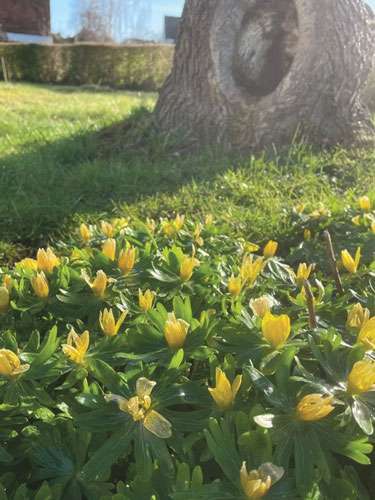
It might seem a cause for celebration that Spring is said to have come a month early this year. But this might not be necessarily a good thing for wildlife. A late frost can kill the new growth but worse, the premature blooming of flowers can cause what it termed an “ecological mismatch”. Plants, insects and birds have evolved to depend on each other. For birds and insects there needs to be synchronicity with plants – so that the food chain functions. A plant bursting into flower prematurely can starve insects, and the birds that depend on them.
A late Spring can be equally hazardous. Animals coming out of hibernation can find themselves without food. Our ancestors also faced dangerous times in the Spring. Long, cold winters with no fresh food meant that they were not in top physical condition, scurvy was not uncommon. No ordering fruit and veg to be flown in from places with milder climates! Nettle tops were one of the first edible green plants – I noticed the little leaf buds pushing through the soil in mid February this year.
In rural areas, a nettle tea was made to ‘strengthen the system’ and there are countless recipes for nettle soup (see this month’s recipe on page 48). I used to make it in the past and it is quite palatable; the sting is removed by the cooking. It was also added to the stew pot as a herb. It needs to be picked and eaten when young – and it is recommended that gloves be worn. Otherwise ensure there is a dock leaf somewhere near as an antidote. Its botanical name is urtica dioica which comes from the Latin uro meaning irritating or burning. It is a downy plant and additionally has little hairs that cause much discomfort – hence it is often called the stinging nettle, to distinguish it from other members of the nettle family. The hairs snap off easily and pierce the skin, acting like hypodermic needles injecting a cocktail of chemicals including serotonin, histamine and formic acid. The Romans, it is said, brought a particularly irritating nettle with them when they came to stimulate their circulation in our cold, damp weather and to treat the resulting rheumatism and arthritis.
The nettle would win no botanical beauty competition but has other valuable uses. In the Middle Ages a mash of nettle roots was placed on balding heads to reverse hair loss. Chemical analysis has found that an extract from the roots controls Dihydrotestosterone (DHT). An excess of DHT causes male pattern balding.
Photo by Andy Bamford
Not all nettle uses are medicinal or nutritional. In the WW1 a shortage of cotton in Germany revived the cultivation of nettles to make fibre from their stems. The population were urged to gather wild nettles to help the war effort – although cultivated nettles yield better fibre. Two captured German uniforms were analysed and it was found that they were made of up to 85% of nettle fibre. 40 kilos of nettles were needed for a single shirt. Making fabric out of nettle stem fibre was not new; other uses were for sacking, fishing nets, and rope. Today there is further research into the use of nettles for textiles to reduce the reliance on cotton, which is not environment friendly because of the heavy use of pesticides in its production, and its carbon footprint. In addition, the working conditions in some countries do not always comply with ethical standards – the connection between cotton and slavery is not just ancient history. Nettles could grow easily in a cooler climate but it does need rich soil to produce good fibres.
Nettles flourish in soils rich in phosphorous – which is essential for good root growth and branching – giving the plant enhanced vigour and early leaf growth. Phosphate loving plants grow where people have lived, thrown their rubbish and been buried. The phosphate, particularly from bones, accumulates and remains in the soil for centuries – and can be an indicator of ancient settlements and deserted villages. Rather gruesome but true, when investigators and forensic archaeologists have studied aerial photographs, they have found that lush growth of nettles can point to mass graves, and ancient battle sites. Spotting large patches of nettles when on your next rural walk might lead to some interesting speculation.
And as if all that were not enough, nettles are great for providing food for the larvae of butterflies such as Red Admirals and small tortoiseshells. A large nettle can produce up to 40,000 seeds a year which is a banquet for the birds.
Beryl Harvey Fields is Cranleigh’s nature conservation site. We need volunteers. For further information: visit our conservation site in Cranleigh – or better, volunteer. Contact Philip Townsend at: for details.












